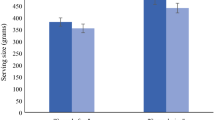Abstract
Objective: It was examined whether caloric conditioning or social learning strategies dominate in taste preference acquisition in children. The caloric learning paradigm predicts that eating or drinking artificially sweetened products, which deliver virtually no energy, will not lead to a taste preference whereas the social learning paradigm predicts that seeing important others modelling the eating and drinking of these ‘light’ products will induce a preference for the taste of light products in the child.
Design: In a 2×2 between subjects factorial design, the amount of energy and social modelling was varied.
Setting: The study was undertaken at primary schools in Maastricht, The Netherlands.
Subjects: Forty-five children participated and six children dropped out. The 39 children who completed the study (14 boys and 25 girls) had a mean age of 67 months (range 51–81, s.d. 5.6).
Interventions: Each subject took part in nine conditioning trials with an individually selected tasting yoghurt which was not preferred very much at the pre-test.
Results: The children in the combined caloric and social condition showed an increase in their preference for the conditioned taste which was larger than a regression-to-the-mean effect (P=0.007), whereas children in the other groups did not.
Conclusion: Caloric and social learning combined, ie modelling the consumption of energy-rich foods or drinks, is the best way to establish taste preferences. Children more easily learn a preference for energy-rich food that is eaten by significant others than for food that is low in energy and eaten by significant others.
European Journal of Clinical Nutrition (2001) 55, 418–422
This is a preview of subscription content, access via your institution
Access options
Subscribe to this journal
Receive 12 print issues and online access
$259.00 per year
only $21.58 per issue
Buy this article
- Purchase on Springer Link
- Instant access to full article PDF
Prices may be subject to local taxes which are calculated during checkout
Similar content being viewed by others
References
Birch LL (1979a) Preschool children's food preferences and consumption patterns J Nutr. Educ. 11 189–192
Birch LL (1979b) Dimensions of preschool children's food preferences J Nutr. Educ. 11 77–80
Birch LL (1980) Effects of peer models' food choices and eating behaviors on preschoolers' food preferences Child Dev. 51 489–496
Birch LL (1987) The acquisition of food acceptance patterns in children In Eating Habits, ed. RA Boakes, DA Popplewell & MJ Burton 107–130 Chichester: John Wiley
Birch LL (1989) Developmental aspects of eating In Handbook of the Psychophysiology of Human Eating, ed. R Shepherd Chichester: John Wile y
Birch LL (1991) Obesity and eating disorders: a developmental perspective Bull. Psychon. Soc. 29 265–272
Birch LL, McPhee L, Steinberg L & Sullivan S (1990) Conditioned flavor preferences in young children Physiol. Behav. 47 501–505
Booth D (1985) Food-conditioned eating preferences and aversions with interoceptive elements: conditioned appetites and satieties Ann. N.Y. Acad. Sci. 443 22–41
Capaldi ED (1996) Conditioned food preferences In Why We Eat What We Eat. The Psychology of Eating, ed. CD Capaldi 53–80 Washington DC: American Psychological Association
Garcia J, Hankins W & Rusiniak K (1974) Behavioral regulations of the milieu interne in man and rat Science 185 824–831
Hendy HM & Raudenbush B (2000) Effectiveness of teacher modeling to encourage food acceptance in preschool children Appetite 34 61–76
Horne PJ, Lowe CF, Flemin PFJ & Dowey AJ (1995) An effective procedure for changing food preferences in 5–7-year-old children Proc. Nutr. Soc. 54 441–452
Johnson S, McPhee L & Birch LL (1991) Conditioned preferences: young children prefer flavors associated with high dietary fat Physiol. Behav. 50 1245–1251
Kern DL, McPhee L, Fisher J, Johnson S & Birch LL (1993) The postingestive consequences of fat condition preferences for flavors associated with high dietary fat Physiol. Behav. 54 71–76
Rogers P (1994) Mechanisms of moreishness and food craving In Pleasure: the Politics and the Reality, ed. D Wharburton 38–49 Chichester: John Wiley
Rozin P (1989) The role of learning in the acquisition of food preference by humans In Handbook of the Psychophysiology of Human Eating, ed. R Shepherd Chichester: John Wiley
Rozin P & Kennel K (1983) Acquired preferences for piquant foods by chimpanzees Appetite 4 69–77
Rozin P & Zellner D (1985) The role of Pavlovian conditioning in the acquisition of food likes and dislikes Ann. N.Y. Acad. Sci. 443 189–202
Sclafani A (1991) Conditioned food preferences Bull. Psychon. Soc. 29 256–260
Sullivan SA & Birch LL (1990) Pass the sugar, pass the salt: experience dictates preference Dev. Psychol. 26 546–551
Acknowledgements
The present study was supported by a grant of the Dutch Sugar Bureau. Quest International (Naarden) is gratefully acknowledged for supplying us with the flavours and aspartame. The Holland Sweetener Company is thanked for the quick delivery of more aspartame. The teachers and children of the schools are thanked gratefully for their participation. Fren Smulders and Eric Schouten are thanked for their statistical advice, Chantal Nederkoorn and Brigitte Boon for their comments on the paper, and Marja Hortulanus for her logistic assistance.
Author information
Authors and Affiliations
Corresponding author
Rights and permissions
About this article
Cite this article
Jansen, A., Tenney, N. Seeing mum drinking a ‘light’ product: is social learning a stronger determinant of taste preference acquisition than caloric conditioning?. Eur J Clin Nutr 55, 418–422 (2001). https://doi.org/10.1038/sj.ejcn.1601175
Received:
Revised:
Accepted:
Published:
Issue Date:
DOI: https://doi.org/10.1038/sj.ejcn.1601175
Keywords
This article is cited by
-
Perceived effective and feasible strategies to promote healthy eating in young children: focus groups with parents, family child care providers and daycare assistants
BMC Public Health (2016)
-
Pavlovian Craving and Overeating: A Conditioned Incentive Model
Current Obesity Reports (2013)
-
Role of parents in the determination of the food preferences of children and the development of obesity
International Journal of Obesity (2004)



